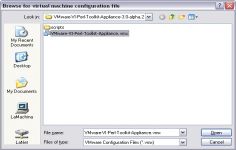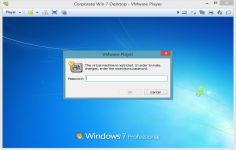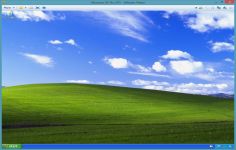 VMware Player 3.1.2
VMware Player 3.1.2
VMware Inc - (Freeware)
Sharing data between host computer and virtual machine is very much possible with VMware Player which makes all very easy.
VMware Player is a software program that allows having multiple operating systems on one computer using more virtual machines. It helps to easy operate any virtual machine created by VMware Workstation, VMware Fusion, VMware Server or VMware ESX, as well as Microsoft Virtual Server virtual machines or Microsoft Virtual PC virtual machines.
With this tool it is possible to create virtual machines and install an operating system without leaving the main system.This program can be very interesting to go from one OS to another to test the compatibility of professional software or for beta testers who can work easily on a given and contained in a virtual machine configuration.
- Title:
- VMware Player 3.1.2
- File Size:
- 104.1 MB
- Requirements:
- Windows 2000 / XP / Vista / Windows7 / XP64 / Vista64 / Windows7 64 / Windows8 / Windows8 64
- Language:
- en-us
- License:
- Freeware
- Date Added:
- 23 Sep 2010
- Publisher:
- VMware Inc
- Homepage:
- http://www.vmware.com
- MD5 Checksum:
- 3F289CB33AF5E425C92D8512FB22A7BA
# Resolved Issues
* Security Fixes
* VMware Player 3.x addresses an installer security issue
- The VMware Player 3.x installer loads an index.htm file located in the current working directory on which VMware Player 3.x is being installed. This might enable attackers to display a malicious file if they manage to get their file onto the system prior to installation.
- The Common Vulnerabilities and Exposures project (cve.mitre.org) has assigned the name CVE-2010-3277 to this issue.
* Third party libpng updated to version 1.2.44
- A buffer overflow condition in libpng is addressed that could potentially lead to code execution with the privileges of the application using libpng. Two potential denial of service issues are also addressed in the update.
- The Common Vulnerabilities and Exposures project (cve.mitre.org) has assigned the names CVE-2010-1205, CVE-2010-0205, and CVE-2010-2249 to these issues.
# Installation, Upgrade, and Compatibility
* In some cases copying an index.html file into the same directory as the VMware Player 3.1.1 installer executable on Windows hosts might cause the VMware Player installer user interface to fail.
* On Linux hosts, if the screen saver becomes active during the VMware Player software update process, the update might fail.
* When downloading software updates via a slow Internet connection, you might receive a timeout error resulting in an unsuccessful download.
# Display
* To improve user experience when using Unity mode on Windows Vista and Windows 7 virtual machines, VMware Player disables Aero when entering Unity mode and re-enables it when you exit Unity mode. To override the disabling of Aero, open the vmx configuration file and add unity.allowCompositingInGuest="TRUE".
* Rebooting an Ubuntu 10.04 host after installing VMware Player, might cause the System Tools option under the Application menu to disappear.
* On Linux hosts, the Cycle to Next/Previous open VM button might not appear consistently in the VMware Player full screen toolbar.
* Attempting to power on a Windows 7 virtual machine named using non-ASCII characters on Ubuntu 10.04 hosts might cause display issues in the Unity Start menu.
* Enabling Aero on hosts with Intel Integrated Graphics processing unit might cause display issues in a virtual machine.
* On Windows hosts, you might experience some usability issues while attempting to interact with Fedora 13 virtual machine applications in Unity mode.
* On Fedora 13 virtual machines, dragging guest applications along the edges of the guest display might cause the mouse functions to become unresponsive.
* On Japanese version of Windows, using non-ASCII characters to name the host might cause the Start menu to not show in Unity mode.
# Miscellaneous
* The DNS server information might not refresh when the virtual machine switches between multiple NICs, such as wired and wireless. Thus leading to a failure in looking up hosts with their DNS names when guest is using NAT.
* If your host system has three parallel ports you might not be able map these ports non-sequentially.
* On Ubuntu guests, the vmware-user component of VMware Tools might become unresponsive after Autologon is enabled on the guest and cause drag and drop or copy and paste operations to fail.
* USB devices with vendor ID 0x1366 might be identified as being manufactured by Asahi KASEI instead of SEGGER.
* Dragon Medical 10.1 from Nuance might not run with more than one core on Windows 7 Ultimate 64-bit guests.
* On Windows 7 guests, you must run a New Hardware scan from the Device Manager menu for Logitech USB audio devices to be recognized. USB devices disconnected from the guest might still appear to be connected in the guest, and the guest might not allow you to reconnect them.
* On some Windows guests, the volume control keys and a few other multimedia keys might not work in a virtual machine.
* Error in NetBIOS forwarding in NAT leads to incorrect resolution of WINS name of the virtual machine.
* On Linux hosts, launching a virtual machine application shortcut that includes either non-ASCII characters or a long path might not work on the first attempt.
Related software
2.2/5 from 183 users


